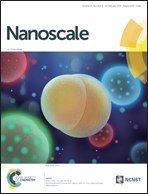Molecular dynamics study of thermal transport in a dinaphtho[2,3-b:2′,3′-f]thieno[3,2-b]thiophene (DNTT) organic semiconductor†
Abstract
The thermal transport in a high-mobility and air-stable small molecule organic semiconductor, dinaphtho[2,3-b:2′,3′-f]thieno[3,2-b]thiophene (DNTT), is simulated by using non-equilibrium molecular dynamics. We find that the thermal conductivity of DNTT has a strong dependence on crystal size and orientation directions (a*, b* and c*). The bulk thermal conductivities of DNTT along the a*, b* and c* directions are 0.73, 0.33 and 0.95 W m−1 K−1, respectively. The polycrystalline nature of the DNTT thin film in the experiment means that it is essential to consider the effects of thermal boundary resistance (TBR) and vacancy on the thermal conductivity. The TBRs across different interfaces are calculated as 7.00 ± 0.26, 6.15 ± 0.13 and 3.20 ± 0.09 × 10−9 m2 K W−1 for the a*–b*, a*–c* and b*–c* interfaces, respectively. On the other hand, the thermal conductivities of DNTT with a vacancy concentration of 6% can be reduced by 44%, 33% and 35% in the a*, b* and c* directions. Our findings indicate that the boundary and defect scattering of phonons has significant effects on the thermal conductivity of organic semiconductors. This work contributes fundamental knowledge to control the thermal properties of organic semiconductors in organic electronic devices.
![Graphical abstract: Molecular dynamics study of thermal transport in a dinaphtho[2,3-b:2′,3′-f]thieno[3,2-b]thiophene (DNTT) organic semiconductor](/en/Image/Get?imageInfo.ImageType=GA&imageInfo.ImageIdentifier.ManuscriptID=C6NR08682A&imageInfo.ImageIdentifier.Year=2017)


 Please wait while we load your content...
Please wait while we load your content...